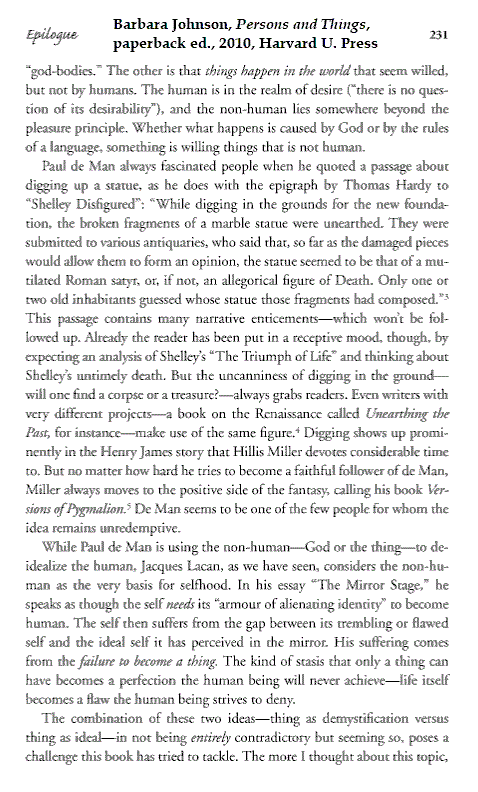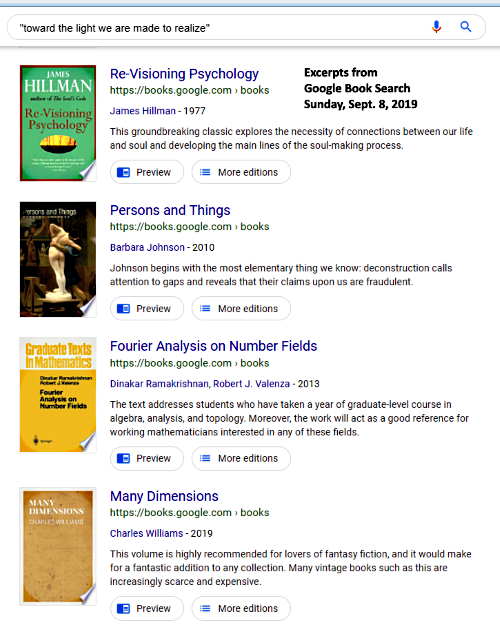Also on March 8, 2018 —
This post was suggested by the word "entanglement' in the previous post.
See as well "Galois (Xor) addition."
Also on March 8, 2018 —
This post was suggested by the word "entanglement' in the previous post.
See as well "Galois (Xor) addition."
See the above title and Barbara Johnson in this journal.
Johnson taught at Harvard for 25 years, starting in 1983.
See also Harvard in the previous post, The Crimson Riddle.
| Harvard University Press on a book, Persons and Things, it published on March 31, 2010 Moving effortlessly between symbolist poetry and Barbie dolls, artificial intelligence and Kleist, Kant, and Winnicott, Barbara Johnson not only clarifies psychological and social dynamics; she also re-dramatizes the work of important tropes—without ever losing sight of the ethical imperative with which she begins: the need to treat persons as persons. In Persons and Things , Johnson turns deconstruction around to make a fundamental contribution to the new aesthetics. She begins with the most elementary thing we know: and reveals that their claims upon us are fraudulent. Johnson revolutionizes the method by showing that the inanimate thing exposed as a delusion is central to fantasy life, that fantasy life, however deluded, should be taken seriously, and that although a work of art “is formed around something missing,” this “void is its vanishing point, not its essence.” She shows deftly and delicately that the void inside Keats’s urn, Heidegger’s jug, or Wallace Stevens’s jar forms the center around which we tend to organize our worlds. The new aesthetics should restore fluidities between persons and things. In pursuing it, Johnson calls upon Ovid, Keats, Poe, Plath, and others who have inhabited this in-between space. The entire process operates via a subtlety that only a critic of Johnson’s caliber could reveal to us. |
I prefer the more straightforward insanity of Operators and Things .
Barbara Johnson reportedly died on Aug. 27, 2009. See that date
in other posts now tagged Autistic Enchantment. (That phrase is
the sort of sneering tag one may expect from deplorable academics.)
(For Harlan Kane)
"While digging in the grounds for the new foundation,
the broken fragments of a marble statue were unearthed."
— From Thomas Hardy, "Barbara of the House of Grebe,"
quoted in an epigraph to Paul de Man's "Shelley Disfigured,"
in turn quoted by Barbara Johnson on page 231 of Persons
and Things (Harvard paperback, 2010).
From "the world of the unintentional, the contingent, the minute,
and the particular" (Kovacevic, U. of Montenegro, 2011) —
Yes, we received your payment. No, it wasn't late, but it was for $78.13, and the bill was for $78.31. Okay, great. Read more: https://www.springfieldspringfield.co.uk/ movie_script.php?movie=the-circle
Another such transposition: Pages 213 and 231 in a search
for "gaps" in a 2010 paperback discussion of Lacan —
These pages are as follows —


(The above title was suggested by today's "Child-Resistant 4×4.")

* Specifically, resistant to the above revelation attributed to Barbara Johnson
by Harvard University Press —
"Deconstruction calls attention to gaps and reveals
that their claims upon us are fraudulent."
A related search at Amazon.com:
Barbara Johnson explains Lacan:
" The 'gap' in the real is the leap
from the empirical to
the signifying articulation
of the object of desire;
it cannot be perceived empirically.
It is 'nothing.' "
— Persons and Things , paperback (2010),
Harvard University Press, page 213
Some mathematical background for yesterday's
remarks "For the Bregnans" and "Lost in Translation"—
"Matching Theory: A Sampler, from Dénes König
to the Present," by Michael D. Plummer, 1991.
See also Matching Theory by Plummer and Lovász.
Translation by Barbara Johnson:
"The minimum number of rows— lines or columns—
that contain all the zeros in a matrix is equal to
the maximum number of zeros
located in any individual line or column ."
In the original:
"situés sur des lignes ou des colonnes distinctes "
Update of 11:30 PM ET May 29, 2014:
Derrida in 1972 was quoting Philippe Sollers, Nombres
(Paris: Éditions du Seuil , 1968). Sollers in turn was
perhaps quoting A. Kaufmann, Méthodes et Modèles
de la Recherche Opérationnelle , Paris, Dunod , 1964,
L'Économie d'Entreprise 10 , vol. 2, page 305:
"Le nombre minimal de rangées
(lignes et/ou colonnes) contenant
tous les zéros d'une matrice, est égal
au nombre maximal de zéros
situés sur des lignes et des colonnes distinctes."
The Harvard Crimson —Magic of Numbers:
|
Saturday night's game… Harvard vs. Brown at Providence—
Related philosophy about divine providence—

See also, from 2002, a note on "light inclosed in the dark" versus the late Harvard philosopher Barbara Johnson.
For some context on Harvard and "the Magic of Numbers" see Summer Reading from 2007.
John Allen Paulos yesterday at Twitter—
"Plato's code cracked? http://bit.ly/ad6k1S
Fascinating if not a hoax or hype."
The story that Paulos linked to is about a British
academic who claims to have found some
symbolism hidden in Plato's writings by
splitting each into 12 parts and correlating
the 12 parts with semitones of a musical scale.
I prefer a different approach to Plato that is
related to the following hoax and hype—
HOAX:
From Dan Brown's novel Angels & Demons (2000)—

HYPE:
This four-elements diamond summarizes the classical
four elements and four qualities neatly, but some scholars
might call the figure "hype" since it deals with an academically
disreputable subject, alchemy, and since its origin is unclear.
For the four elements' role in some literature more respectable
than Dan Brown's, see Poetry's Bones.
Although an author like Brown might spin the remarks
below into a narrative— The Plato Code — they are
neither hoax nor hype.
NOT HOAX:

NOT HYPE:
For related non-hoax, non-hype remarks, see
The Rational Enterprise: Logos in Plato's Theaetetus,
by Rosemary Desjardins.
Those who prefer hoax and hype in their philosophy may consult
the writings of, say, Barbara Johnson, Rosalind Krauss, and—
in yesterday's NY Times's "The Stone" column— Nancy Bauer.

— The New York Times
From today's NY Times—

Obituaries for mystery authors
Ralph McInerny and Dick Francis
From the date (Jan. 29) of McInerny's death–
"…although a work of art 'is formed around something missing,' this 'void is its vanishing point, not its essence.'"
– Harvard University Press on Persons and Things (Walpurgisnacht, 2008), by Barbara Johnson
From the date (Feb. 14) of Francis's death–

The EIghtfold Cube
The "something missing" in the above figure is an eighth cube, hidden behind the others pictured.
This eighth cube is not, as Johnson would have it, a void and "vanishing point," but is instead the "still point" of T.S. Eliot. (See the epigraph to the chapter on automorphism groups in Parallelisms of Complete Designs, by Peter J. Cameron. See also related material in this journal.) The automorphism group here is of course the order-168 simple group of Felix Christian Klein.
For a connection to horses, see
a March 31, 2004, post
commemorating the birth of Descartes
and the death of Coxeter–
Putting Descartes Before Dehors


For a more Protestant meditation,
see The Cross of Descartes—

"I've been the front end of a horse
and the rear end. The front end is better."
— Old vaudeville joke
For further details, click on
the image below–
Notre Dame Philosophical Reviews
Part I:
"…although a work of art 'is formed around something missing,' this 'void is its vanishing point, not its essence.' She shows deftly and delicately that the void inside Keats’s urn, Heidegger’s jug, or Wallace Stevens’s jar forms the center around which we tend to organize our worlds."
— Harvard University Press on Persons and Things (April 30, 2008), by Barbara Johnson
Part II:

Part III:
From the date of Barbara Johnson's death:
"Mathematical relationships were
enough to satisfy him, mere formal
relationships which existed at
all times, everywhere, at once."
– Broken Symmetries, 1983
| X | ||
| X | ||
| X |
The X's refer to the pattern on the
cover of a paperback edition
of Nine Stories, by J. D. Salinger.
Salinger died on Wednesday.
"You remember that book he sent me
from Germany? You know–
those German poems."
In Germany, Wednesday was
Holocaust Memorial Day, 2010.
From this journal:
Friday December 5, 2008Mirror-Play of
the Fourfold For an excellent commentary View selected pages Play and the Aesthetic Dimension (Mihai I. Spariosu, Related material: – and Theme and Variations. |
Transition to the
Garden of Forking Paths–
(See For Baron Samedi)–
The Found Symbol

and Dissemination, by Jacques Derrida,
translated by Barbara Johnson,
London, Athlone Press, 1981–
Pages 354-355
On the mirror-play of the fourfold
Pages 356-357
Shaking up a whole culture
Pages 358-359
Cornerstone and crossroads
Pages 360-361
A deep impression embedded in stone
Pages 362-363
A certain Y, a certain V
Pages 364-365
The world is Zeus's play
Page 366
It was necessary to begin again
“…one has to be willing
to tolerate ambiguity,
even to be crazy.”
“Bohr’s words?”
“The party line….”
— Quotation from
Secret Passages linked to on
the date of Johnson’s death
“Yes and no (what else?).”
— Barbara Johnson in
The Wake of Deconstruction
Related material:
For more on ambiguity,
see this journal’s entries of
March 7, 8, and 9, 2007.
For more on craziness,
see this journal’s entries of
March 10, 2007.
“The letter acts like a signifier precisely to the extent that its function in the story does not require that its meaning be revealed.”
— Barbara Johnson, “The Frame of Reference,” an essay on a story by Poe


As for Johnson’s title,
“The Frame of Reference,”
see the window above,
Epiphany 2007, and
Church of the
Forbidden Planet.
Happy birthday,
Edgar Allan Poe.
May '68 Revisited
"At his final Paris campaign rally… Mr. Sarkozy declared himself the candidate of the 'silent majority,' tired of a 'moral crisis in France not seen since the time of Joan of Arc.'
'I want to turn the page on May 1968,' he said of the student protests cum social revolution that rocked France almost four decades ago.
'The heirs of May '68 have imposed the idea that everything has the same worth, that there is no difference between good and evil, no difference between the true and the false, between the beautiful and the ugly and that the victim counts for less than the delinquent.'
Denouncing the eradication of 'values and hierarchy,' Mr. Sarkozy accused the Left of being the true heirs and perpetuators of the ideology of 1968."
— Emma-Kate Symons, Paris, May 1, 2007, in The Australian
Related material:
From the translator's introduction to Dissemination, by Jacques Derrida, translated by Barbara Johnson, University of Chicago Press, 1981, page xxxi —
"Both Numbers and 'Dissemination' are attempts to enact rather than simply state the theoretical upheavals produced in the course of a radical reevaluation of the nature and function of writing undertaken by Derrida, Sollers, Roland Barthes, Julia Kristeva and other contributors to the journal Tel Quel in the late 1960s. Ideological and political as well as literary and critical, the Tel Quel program attempted to push to their utmost limits the theoretical revolutions wrought by Marx, Freud, Nietzsche, Mallarme, Levi-Strauss, Saussure, and Heidegger."
This is the same Barbara Johnson who has served as the Frederic Wertham Professor of Law and Psychiatry in Society at Harvard.
Johnson has attacked "the very essence of Logic"–
"… the logic of binary opposition, the principle of non-contradiction, often thought of as the very essence of Logic as such….
Now, my understanding of what is most radical in deconstruction is precisely that it questions this basic logic of binary opposition….
Instead of a simple 'either/or' structure, deconstruction attempts to elaborate a discourse that says neither 'either/or', nor 'both/and' nor even 'neither/nor', while at the same time not totally abandoning these logics either."
— "Nothing Fails Like Success," SCE Reports 8, 1980
Such contempt for logic has resulted, for instance, in the following passage, quoted approvingly on page 342 of Johnson's translation of Dissemination, from Philippe Sollers's Nombres (1966):
"The minimum number of rows– lines or columns– that contain all the zeros in a matrix is equal to the maximum number of zeros located in any individual line or column."
For a correction of Sollers's Johnson's damned nonsense, click here.
Update of May 29, 2014:
The error, as noted above, was not Sollers's, but Johnson's.
See also the post of May 29, 2014 titled 'Lost in Translation.'
"The logic behind such utterances is the logic
of binary opposition, the principle of non-contra-
diction, often thought of as the very essence of
Logic as such….
Now, my understanding of what is most radical
in deconstruction is precisely that it questions
this basic logic of binary opposition….
Instead of a simple 'either/or' structure,
deconstruction attempts to elaborate a discourse
that says neither "either/or", nor "both/and"
nor even "neither/nor", while at the same time
not totally abandoning these logics either."
— Harvard professor Barbara Johnson
in "Nothing Fails Like Success."
(See the previous entry, Day Without Logic.)
Those who value literary theory
more than they value truth
may prefer, on this
International Women's Day,
the "mandorla" interpretation
of the above diagrams.
For this interpretation, see
Death and the Spirit III,
Burning Bright,
and
The Agony and the Ya-Ya.
Symbol of the Dec. 1
“Day Without Art“
This resembles the following symbol,
due to logician Charles Sanders Peirce,
of the logic of binary opposition:

(For futher details on the role
of this symbol in logic, see
Chinese Jar Revisited.)
On this, International Women’s Day,
we might also consider the
widely quoted thoughts on logic of
Harvard professor Barbara Johnson:

Detail:

“Instead of a simple ‘either/or’ structure,
deconstruction attempts to elaborate a discourse
that says neither “either/or”, nor “both/and”
nor even “neither/nor”, while at the same time
not totally abandoning these logics either.”
It may also be of interest on
International Women’s Day
that in the “box style” I Ching
(suggested by a remark of
Jungian analyst
Marie-Louise von Franz)
the symbol

denotes
Hexagram 2,
The Receptive.
Make a Différance
From Frida Saal's
Lacan  Derrida:
Derrida:
"Différance is that which all signs have, what constitutes them as signs, as signs are not that to which they refer: i) they differ, and hence open a space from that which they represent, and ii) they defer, and hence open up a temporal chain, or, participate in temporality. As well, following de Sassure's famous argument, signs 'mean' by differing from other signs. The coined word 'différance' refers to at once the differing and the deferring of signs. Taken to the ontological level†, the differing and deferring of signs from what they mean, means that every sign repeats the creation of space and time; and ultimately, that différance is the ultimate phenomenon in the universe, an operation that is not an operation, both active and passive, that which enables and results from Being itself."
 22. Without using the Pythagorean Theorem prove that the hypotenuse of an isosceles right triangle will have the length 22. Without using the Pythagorean Theorem prove that the hypotenuse of an isosceles right triangle will have the length  if the equal legs have the length 1. Suggestion: Consider the similar triangles in Fig. 39. if the equal legs have the length 1. Suggestion: Consider the similar triangles in Fig. 39.23. The ancient Greeks regarded the Pythagorean Theorem as involving areas, and they proved it by means of areas. We cannot do so now because we have not yet considered the idea of area. Assuming for the moment, however, the idea of the area of a square, use this idea instead of similar triangles and proportion in Ex. 22 above to show that x =  . .
— Page 98 of Basic Geometry, by George David Birkhoff, Professor of Mathematics at Harvard University, and Ralph Beatley, Associate Professor of Education at Harvard University (Scott, Foresman 1941) |
The above is from October 1999.
See also Naturalized Epistemology,
from Women's History Month, 2001.
Readings for
St. Patrick's Day
Time of this entry: 12:00:36 PM.
Hence,
"Here the climax of the darkening is reached. The dark power at first held so high a place that it could wound all who were on the side of good and of the light. But in the end it perishes of its own darkness, for evil must itself fall at the very moment when it has wholly overcome the good, and thus consumed the energy to which it owed its duration."
Narrativity: Theory and Practice, by Philip John Moore Sturgess
Sturgess's book deals with the narrative logic of the above novels by Koestler and Conrad, as well as some Irish material:
| Narrativity: Theory and Practice | |||||||||||||||||||||||||||||||||||||||||||||||||||
|
These readings are in opposition to the works of Barbara Johnson published by Harvard University Press.
For some background, see The Shining of May 29 (JFK's birthday).
Discussion question:
In the previous entry, who represents the
Hexagram 36 "dark power"
Powered by WordPress